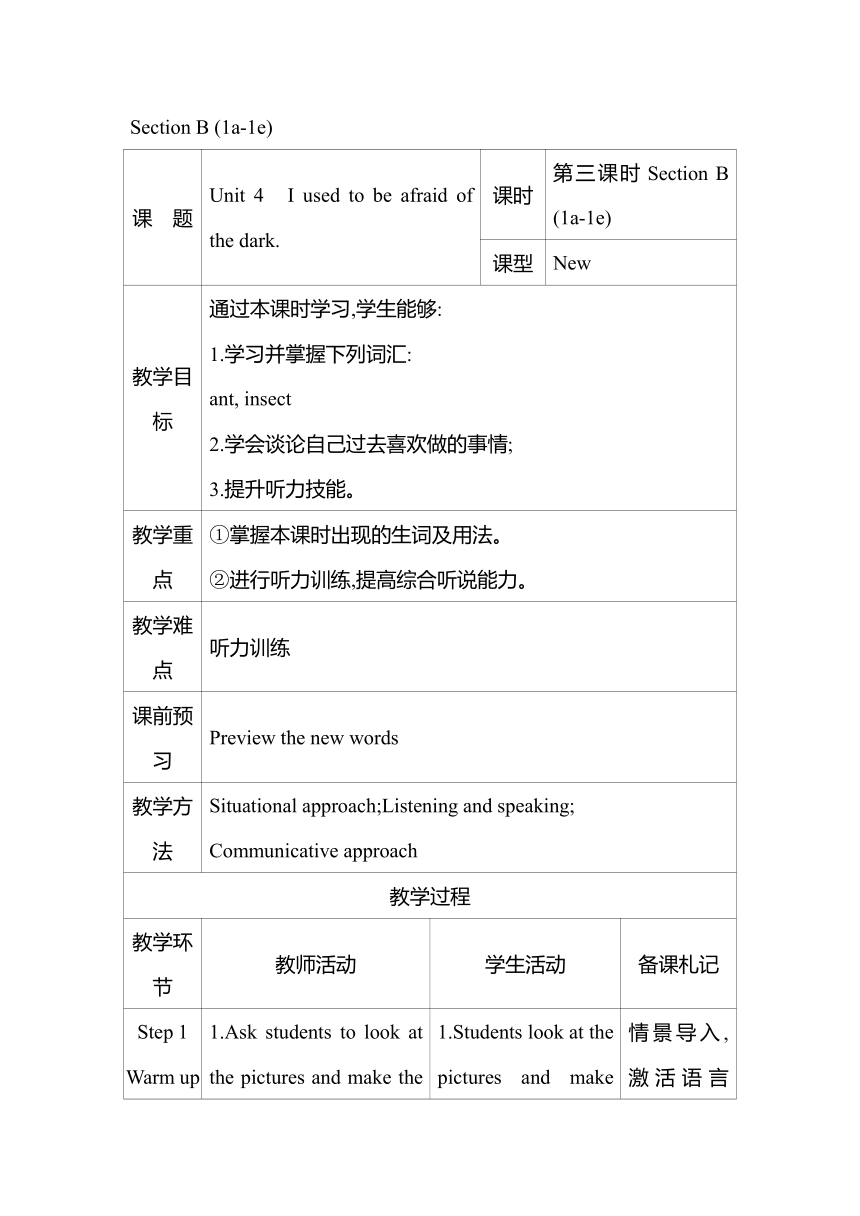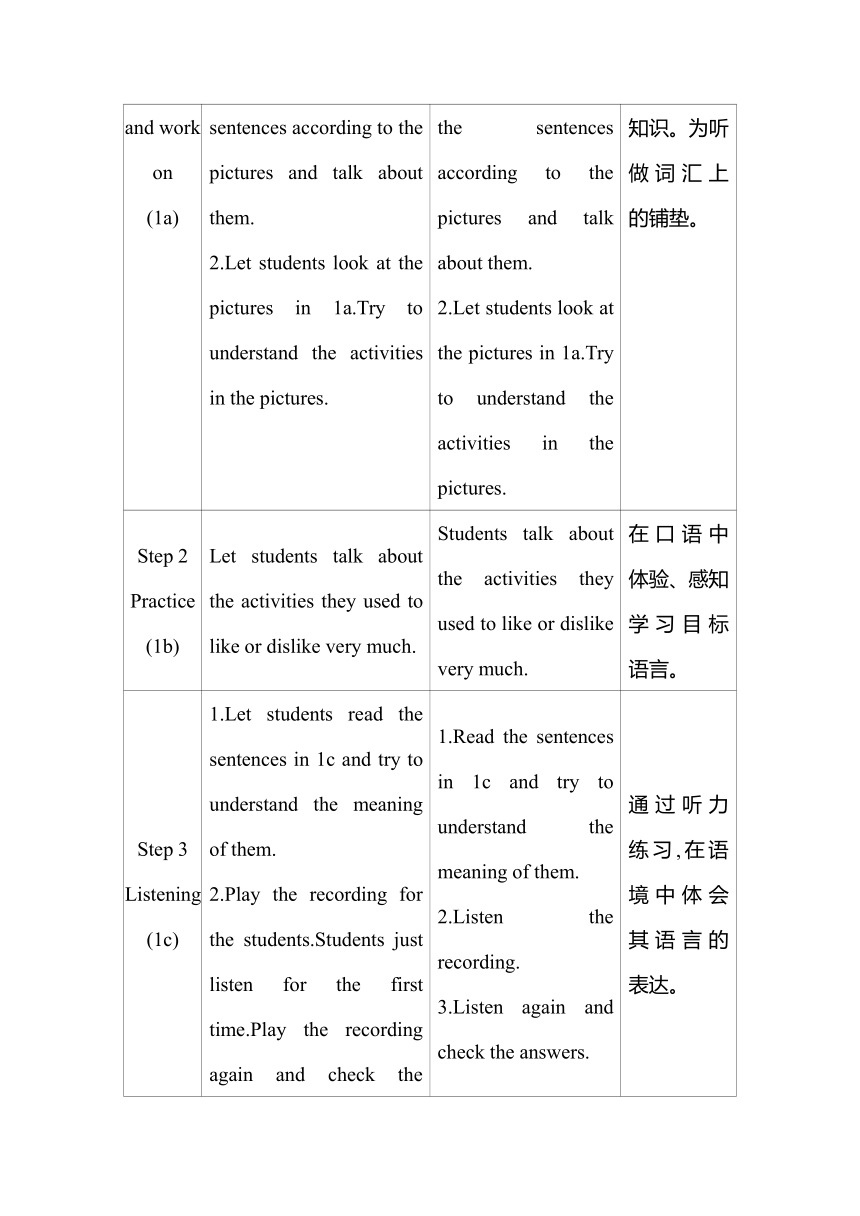Unit 4 I used to be afraid of the dark. Section B (1a-1e)教案(表格式)2024-2025学年人教版英语九年级全一册
文档属性
| 名称 | Unit 4 I used to be afraid of the dark. Section B (1a-1e)教案(表格式)2024-2025学年人教版英语九年级全一册 |  | |
| 格式 | docx | ||
| 文件大小 | 17.4KB | ||
| 资源类型 | 教案 | ||
| 版本资源 | 人教新目标(Go for it)版 | ||
| 科目 | 英语 | ||
| 更新时间 | 2024-06-26 18:58:18 | ||
图片预览


文档简介
Section B (1a-1e)
课 题 Unit 4 I used to be afraid of the dark. 课时 第三课时Section B (1a-1e)
课型 New
教学目标 通过本课时学习,学生能够: 1.学习并掌握下列词汇: ant, insect 2.学会谈论自己过去喜欢做的事情; 3.提升听力技能。
教学重点 ①掌握本课时出现的生词及用法。 ②进行听力训练,提高综合听说能力。
教学难点 听力训练
课前预习 Preview the new words
教学方法 Situational approach;Listening and speaking; Communicative approach
教学过程
教学环节 教师活动 学生活动 备课札记
Step 1 Warm up and work on (1a) 1.Ask students to look at the pictures and make the sentences according to the pictures and talk about them. 2.Let students look at the pictures in 1a.Try to understand the activities in the pictures. 1.Students look at the pictures and make the sentences according to the pictures and talk about them. 2.Let students look at the pictures in 1a.Try to understand the activities in the pictures. 情景导入,激活语言知识。为听做词汇上的铺垫。
Step 2 Practice (1b) Let students talk about the activities they used to like or dislike very much. Students talk about the activities they used to like or dislike very much. 在口语中体验、感知学习目标语言。
Step 3 Listening (1c) 1.Let students read the sentences in 1c and try to understand the meaning of them. 2.Play the recording for the students.Students just listen for the first time.Play the recording again and check the sentences students hear. 3.Check the answers. 1.Read the sentences in 1c and try to understand the meaning of them. 2.Listen the recording. 3.Listen again and check the answers. 通过听力练习,在语境中体会其语言的表达。
Step 4 Listening (1d) Let students read the sentences in 1d first.Tell students to listen again and fill in the blanks with the right words. Students read the sentences in 1d first.Students listen again and fill in the blanks with the right words. 通过听力练习,在语境中体会其语言的表达。
续表
教学环节 教师活动 学生活动 备课札记
Step 5 (1e) 1.Let students work in pare yourself with your partner. 2.Let some pairs make a conversation before the class. 1.Students work in pare yourself with your partner. 2.Make a conversation before the class. 通过进行口语结对活动,在交流信息过程中,进行真实的交际问答活动。在听力练习和小对话口语练习的基础上,进行角色对话表演,开展有实际意义的交际运用活动。
Step 6 Homework Remember the words and phrases in this lesson.
板书设计 Section B (1a-1e) New words:ant, insect
教学反思 本节课的教学活动设计能够创设丰富的语境,设置循序渐进的学习任务,充分发挥学生的主体作用,引导学生合作学习、自主探究,重视“预习——展示——练习——反馈”的学习过程。
资料链接 留守儿童(The Left-behind Children) 留守儿童,是指父母双方或一方外出到城市打工,而自己留在农村生活的孩子们。他们一般与自己的父亲或母亲中的一人,或者与上辈亲人,甚至父母的其他亲戚、朋友一起生活。留守儿童问题是近年来一个突出的社会问题。 2012年9月,教育部公布义务教育随迁子女超1 260万,义务教育阶段留守儿童2 200万。而根据权威调查,中国农村目前留守儿童数量超过了5 800万人。57.2%的留守儿童是父母一方外出,42.8%的留守儿童是父母同时外出。留守儿童中的79.7%由爷爷、奶奶或外公、外婆抚养,13%的孩子被托付给亲戚、朋友,7.3%为不确定或无人监护。留守的少年儿童正处于成长发育的关键时期,他们无法享受到父母在思想认识及价值观念上的引导和帮助,成长中缺少了父母情感上的关注和呵护,极易产生认识、价值观上的偏离和个性、心理发展的异常。 2015年6月16日至18日,习近平主席在贵州调研期间,强调要做好保障和改善民生工作,要关心留守儿童和老年人。
课 题 Unit 4 I used to be afraid of the dark. 课时 第三课时Section B (1a-1e)
课型 New
教学目标 通过本课时学习,学生能够: 1.学习并掌握下列词汇: ant, insect 2.学会谈论自己过去喜欢做的事情; 3.提升听力技能。
教学重点 ①掌握本课时出现的生词及用法。 ②进行听力训练,提高综合听说能力。
教学难点 听力训练
课前预习 Preview the new words
教学方法 Situational approach;Listening and speaking; Communicative approach
教学过程
教学环节 教师活动 学生活动 备课札记
Step 1 Warm up and work on (1a) 1.Ask students to look at the pictures and make the sentences according to the pictures and talk about them. 2.Let students look at the pictures in 1a.Try to understand the activities in the pictures. 1.Students look at the pictures and make the sentences according to the pictures and talk about them. 2.Let students look at the pictures in 1a.Try to understand the activities in the pictures. 情景导入,激活语言知识。为听做词汇上的铺垫。
Step 2 Practice (1b) Let students talk about the activities they used to like or dislike very much. Students talk about the activities they used to like or dislike very much. 在口语中体验、感知学习目标语言。
Step 3 Listening (1c) 1.Let students read the sentences in 1c and try to understand the meaning of them. 2.Play the recording for the students.Students just listen for the first time.Play the recording again and check the sentences students hear. 3.Check the answers. 1.Read the sentences in 1c and try to understand the meaning of them. 2.Listen the recording. 3.Listen again and check the answers. 通过听力练习,在语境中体会其语言的表达。
Step 4 Listening (1d) Let students read the sentences in 1d first.Tell students to listen again and fill in the blanks with the right words. Students read the sentences in 1d first.Students listen again and fill in the blanks with the right words. 通过听力练习,在语境中体会其语言的表达。
续表
教学环节 教师活动 学生活动 备课札记
Step 5 (1e) 1.Let students work in pare yourself with your partner. 2.Let some pairs make a conversation before the class. 1.Students work in pare yourself with your partner. 2.Make a conversation before the class. 通过进行口语结对活动,在交流信息过程中,进行真实的交际问答活动。在听力练习和小对话口语练习的基础上,进行角色对话表演,开展有实际意义的交际运用活动。
Step 6 Homework Remember the words and phrases in this lesson.
板书设计 Section B (1a-1e) New words:ant, insect
教学反思 本节课的教学活动设计能够创设丰富的语境,设置循序渐进的学习任务,充分发挥学生的主体作用,引导学生合作学习、自主探究,重视“预习——展示——练习——反馈”的学习过程。
资料链接 留守儿童(The Left-behind Children) 留守儿童,是指父母双方或一方外出到城市打工,而自己留在农村生活的孩子们。他们一般与自己的父亲或母亲中的一人,或者与上辈亲人,甚至父母的其他亲戚、朋友一起生活。留守儿童问题是近年来一个突出的社会问题。 2012年9月,教育部公布义务教育随迁子女超1 260万,义务教育阶段留守儿童2 200万。而根据权威调查,中国农村目前留守儿童数量超过了5 800万人。57.2%的留守儿童是父母一方外出,42.8%的留守儿童是父母同时外出。留守儿童中的79.7%由爷爷、奶奶或外公、外婆抚养,13%的孩子被托付给亲戚、朋友,7.3%为不确定或无人监护。留守的少年儿童正处于成长发育的关键时期,他们无法享受到父母在思想认识及价值观念上的引导和帮助,成长中缺少了父母情感上的关注和呵护,极易产生认识、价值观上的偏离和个性、心理发展的异常。 2015年6月16日至18日,习近平主席在贵州调研期间,强调要做好保障和改善民生工作,要关心留守儿童和老年人。
同课章节目录
- Unit 1 How can we become good learners.
- Section A
- Section B
- Unit 2 I think that mooncakes are delicious!
- Section A
- Section B
- Unit 3 Could you please tell me where the restroom
- Section A
- Section B
- Unit 4 I used to be afraid of the dark.
- Section A
- Section B
- Unit 5 What are the shirts made of?
- Section A
- Section B
- Review of Units 1-5
- Unit 6 When was it invented?
- Section A
- Section B
- Unit 7 Teenagers should be allowed to choose their
- Section A
- Section B
- Unit 8 It must belong to Carla.
- Section A
- Section B
- Unit 9 I like music that I can dance to.
- Section A
- Section B
- Unit 10 You're supposed to shake hands.
- Section A
- Section B
- Review of Units 6-10
- Unit 11 Sad movies make me cry.
- Section A
- Section B
- Unit 12 Life is full of the unexpected
- Section A
- Section B
- Unit 13 We're trying to save the earth!
- Section A
- Section B
- Unit 14 I remember meeting all of you in Grade 7.
- Section A
- Section B
- Review of Units 11-14
